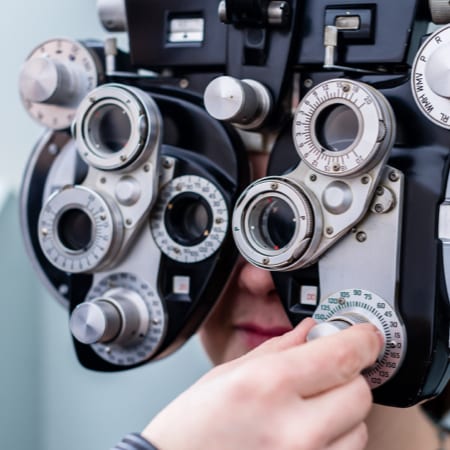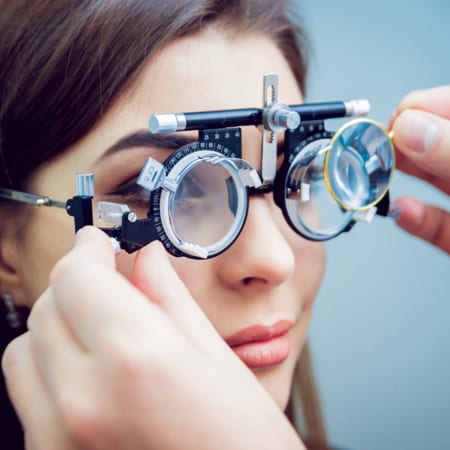If you’ve been wondering why your vision sometimes feels slightly off or why reading road signs feels unusually challenging, astigmatism might be at play. Astigmatism is a common eye condition that causes blurry or distorted vision because the eye isn’t perfectly round. Although it’s not a health-threatening issue, it can affect your daily life by making tasks like reading, driving, or working on screens frustrating.
Astigmatism can develop when you’re older, but getting older is not the only reason someone may have blurry vision. With a comprehensive eye exam, we can find the cause and make a recommendation for glasses, contact lenses, or laser eye surgery.
How Does Astigmatism Affect Your Eye Shape?
Astigmatism occurs when the shape of your cornea or lens is slightly irregular. Normally, the eye is smooth and spherical, like a basketball. This shape helps light enter the eye and focuses it evenly onto the retina, giving you clear vision. However, with astigmatism, the eye is shaped more like a football or an egg.
This uneven curve means that light doesn’t focus evenly, causing blurry or distorted vision at all distances. There are 2 primary types of astigmatism:
- Corneal Astigmatism: Caused by an irregularly shaped cornea.
- Lenticular Astigmatism: Caused by an irregular curvature in the lens.
There is some evidence that astigmatism can be influenced by genetics. So, if you have astigmatism, there’s a greater chance that your kids could develop it as well. However, that’s not the only factor.
Can You Develop Astigmatism Later in Life?
While many people are born with this condition, changes in your eyes as you age can lead to its development. Most things that can affect the shape of your eye could lead to astigmatism, including:
- Eye injuries
- Surgeries
- Keratoconus
Furthermore, simply aging can cause gradual changes in your vision, and it’s not always obvious what’s going on. This is why regular eye exams are so important—they help detect any changes early on, allowing for timely prescription adjustments or other treatments that can keep your vision clear.
How Do You Know if You Have Astigmatism?
Astigmatism often reveals itself through specific symptoms. Some of the most common include:
- Blurred or distorted vision
- Eye strain, particularly after prolonged time focusing
- Frequent headaches
- Difficulty seeing clearly at night, especially while driving
- Constant squinting
People with astigmatism often struggle to focus on fine details. For example, someone without astigmatism might see crisp, sharp letters on a page, while someone with astigmatism might see those same letters as smudgy or shadowed.
Additionally, astigmatism can cause issues at different distances. You might notice trouble focusing on objects close to you, far away, or both. If you’ve been experiencing any of these symptoms, it’s worth scheduling an eye exam to confirm whether astigmatism could be the cause.

How Is Astigmatism Diagnosed?
A comprehensive eye exam is the most effective way to diagnose astigmatism. During the exam, your optometrist will evaluate how your eyes focus light and check for any irregularities in their shape.
Eye exams to diagnose astigmatism usually include tests such as:
- Visual acuity test: Reading letters on a chart to measure visual sharpness.
- Keratometry: Measuring the curvature of your cornea to detect irregularities.
- Refraction test: Using a series of lenses to determine the correct prescription for clarity.
- Autorefractor exam: A tool that uses light to measure how your eye focuses.
These exams are relatively simple while being comprehensive. They provide your optometrist with the information needed to identify astigmatism and determine how to correct it.

What Do People Often Confuse Astigmatism With?
Astigmatism can sometimes be mistaken for other vision problems. Most of the time, these are other refractive errors such as nearsightedness (difficulty seeing things far away) or farsightedness (difficulty seeing things up close). These issues may occur alongside astigmatism, but they’re not the same.
Another common misconception is linking astigmatism with eye fatigue. While strain and discomfort are symptoms, don’t dismiss them as minor inconveniences, as they could indicate the need for corrective measures.
Blurry vision on its own has many different causes. From dry eye to eye diseases, blurriness is one of the first things many people notice. When you have blurry vision, you need to consider other symptoms too, or talk to your optometrist, to figure out what’s actually going on.
Corrective Options for Astigmatism
The good news is that astigmatism is highly correctable, with a range of options tailored to your needs and lifestyle preferences.
Eyeglasses
Eyeglasses with special cylindrical lenses are the most common and straightforward way to correct astigmatism. These lenses help adjust the way light enters your eyes, allowing it to focus more precisely on the retina. Plus, glasses are easy to wear and come in a variety of styles to suit your personality.
Contact Lenses
For a long time, finding contact lenses for astigmatism was difficult. That’s not the story anymore. Contact lenses offer the same correction benefits as eyeglasses but may provide a wider field of vision. Toric lenses are designed specifically to fit the irregular shape of eyes affected by astigmatism. Rigid gas-permeable lenses and hybrid lenses are also options for certain cases.
Laser Eye Surgery
If you’re looking for a solution that doesn’t involve glasses or contacts, laser eye surgery like LASIK or PRK (photorefractive keratectomy) may be an option. These procedures reshape the cornea to correct its irregular curvature. However, not everyone is a candidate for these treatments, so you should start by discussing this option with your optometrist or ophthalmologist.
We Can Help You Take the First Step Toward Clear Vision
Astigmatism doesn’t have to be a blurry chapter in your story. Learning what astigmatism looks like and speaking with your eye doctor are the first steps toward clearer vision, whether it’s with glasses, contact lenses, or laser eye surgery.
You can start your journey to clearer sight by visiting our team at Erie Shores Eyecare. Our knowledgeable optometrists are here to help assess your vision, guide you through your options, and help keep your eye health in great shape.
Call us today or book your appointment online.

















